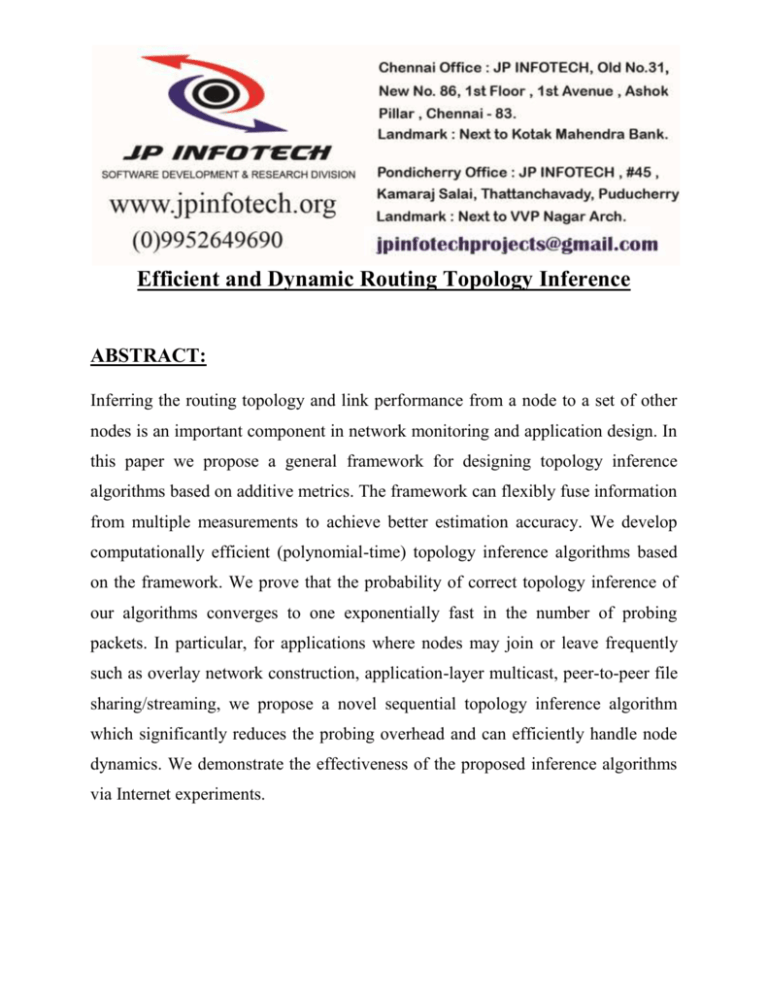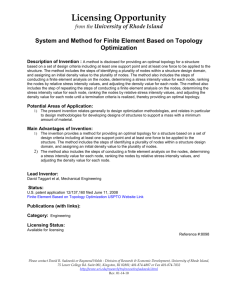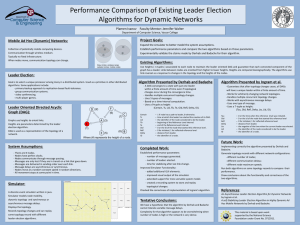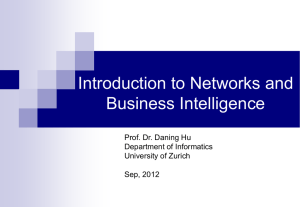Efficient and Dynamic Routing Topology Inference ABSTRACT
advertisement

Efficient and Dynamic Routing Topology Inference
ABSTRACT:
Inferring the routing topology and link performance from a node to a set of other
nodes is an important component in network monitoring and application design. In
this paper we propose a general framework for designing topology inference
algorithms based on additive metrics. The framework can flexibly fuse information
from multiple measurements to achieve better estimation accuracy. We develop
computationally efficient (polynomial-time) topology inference algorithms based
on the framework. We prove that the probability of correct topology inference of
our algorithms converges to one exponentially fast in the number of probing
packets. In particular, for applications where nodes may join or leave frequently
such as overlay network construction, application-layer multicast, peer-to-peer file
sharing/streaming, we propose a novel sequential topology inference algorithm
which significantly reduces the probing overhead and can efficiently handle node
dynamics. We demonstrate the effectiveness of the proposed inference algorithms
via Internet experiments.
EXISTING SYSTEM:
The common approach to use a routing topology from a source node to a
destination node in the internet is to use trace route.
Due to the trace route the network packet are lost and overlay is occurred in
the internet.
The applications used is particularly only for the peer to peer to
communicate with other nodes for file sharing and multimedia streaming.
The network tomography utilizes end to end packet probing measurements
so that the packet loss and delay is measured conducted by the end host.
DISADVANTAGES OF EXISTING SYSTEM:
o Loss of packets and data in network.
o Overlay in internet.
o Waste of recourses and time.
PROPOSED SYSTEM:
In the unicast probing the source node sends a string to the destination node
in a back to back end uncast packets one packet for each destination node
respectively.
In the multicast probing the internal node of the routing tree receives a
packet from its parent it will send a copy of the packet to all its children on
the tree.
The designing topology inference algorithms based on additive metrics.
We proposed a sequential topology inference algorithm to address the
probing scalability problem and handle dynamic node joining and leaving
efficiently.
So by this we can send the packet form source to destination in a quick time
by using the topology distributed network.
ADVANTAGES OF PROPOSED SYSTEM:
1. A sudden failure of a node poses a challenge since the network may get
partitioned. This paper presents sequential topology inference algorithm; a
distributed algorithm for sequential topology inference algorithm. sequential
topology inference algorithm strives to efficiently restore the network connectivity
after a node failure.
2. It restores the failed or deleted node, so there is no way to occur time
delay and data lose.
MODULES:
1) NETWORK MODEL
2) Sender
3) Routers
4) Neighbor joining CONNECTIVITY
5) Receivers
MODULES DESCSRIPTION:
1) NETWORK MODEL
Let G = (V; E) denote the topology of the network, which is a directed graph with
node set V (end hosts, internal switches and routers, etc.) and link set E
(communication links that join the nodes). For any nodes i and j in the network, if
the underlying routing algorithm returns a sequence of links that connect j to i, we
say j is reachable from i. We assume that during the measurement period, the
underlying routing algorithm determines a unique path from a node to another
node that is reachable from it. Hence the physical routing topology from a source
node to a set of (reachable) destination nodes is a (directed) tree.
From the physical routing topology, we can derive a logical routing tree which
consists of the source node, the destination nodes, and the branching nodes
(internal nodes with at least two outgoing links) of the physical routing tree. A
logical link may comprise more than one consecutive physical links, and the
degree of an internal node on the logical routing tree is at least three. In this paper
we consider topology inference of logical routing trees and we use the routing tree
to express the logical routing tree for simplicity.
2) Sender
This is the sender node of our concept, and all the nodes are placed in a seapared in
a each position. Maintaining a List of One-Hop Neighbors The only knowledge,
which RNJ requires, is for each node to have a list of its 1-hop neighbors with their
relativeposition and proximity. Each entry in the table contains two parameters
{Node_ID, Relative position}, where Node_ID is a unique identification assigned
to each node in the WSN. The 1-hop table would have mixed refresh and stale
entries while restoring connectivity, until the WSN converges to a new topology. A
node that changes its position will inform its neighbors beforehand in order to
avoid being wrongfully perceived as faulty.
3) Routers:
This is the next level of sender.here we are going to implement a RNJ algorithm
concept.so when this router nodes are added or deleted then find out a
corresponding next node Is restored in this position. and also maintain another
links to receiver nodes.
4) Neighbor joining CONNECTIVITY
We address these issues in this section. We design procedures to add a node to
(add_node) and delete a node from (delete_node) a routing tree. These procedures
can handle node joining and leaving efficiently, and are particularly useful for
applications where node dynamics are prevalent. Based on the add_node
procedure, we propose a novel sequential topology inference algorithm, which
greatly reduces the probing overhead under unicast packet pair probing.
We first present a topology inference algorithm using (estimated) path lengths and
shared path lengths as the input. The algorithm is a grouping type algorithm. It can
be viewed as a rooted version of the widely used neighbor-joining algorithm for
constructing phylogenetic trees from distances. The algorithm begins with a leaf
set including all the destination nodes. In each step it selects a group of nodes that
are likely to be neighbors (i.e., siblings, nodes with the same parent on the tree),
deletes them from the leaf set, creates a new node as their parent and adds that
node to the leaf set. The whole process is iterated until there is only one node left
in the leaf set, which will be the child of the root (source node).
The RNJ algorithm (and other existing topology inference algorithms) may have
some limitations. First, the focus of previous studies is on a relatively stable set of
nodes. In real applications (e.g., P2P applications), the destination nodes that a
source node communicates with will often change over time. Hence the routing
tree topology will also change over time. When an existing destination node
leaves, it is straightforward to derive the updated routing tree topology. When a
new destination node joins, running the RNJ algorithm over the new set of
destination nodes to infer the updated routing tree topology is not efficient when
the nodes join and leave frequently. The second limitation is the probing
scalability problem under unicast probing.
The RNJ algorithm requires estimated shared path lengths from the source node to
all pairs of the destination nodes as the input.
For a source node s and a set of destination nodes D, we can apply the add_node
procedure over the nodes in D in sequence to construct the routing tree topology
incrementally, as described in Algorithm 2. We compare the RNJ algorithm and
the sequential topology inference algorithm in Table I. We assume all probings
have the same sample size and time interval between two consecutive probes.
Under multicast probing, the RNJ algorithm is more efficient (for building the
whole tree); while under unicast packet pair probing, the sequential topology
inference algorithm is more efficient, in terms of the probing traffic and probing
time. In both cases the sequential topology inference algorithm is more
computationally efficient than the RNJ algorithm.
5. Receivers:
These nodes are arranged in receiver of the every router nodes. So anyone nodes
will go for a restoring position into a router node.
SYSTEM REQUIREMENTS:
HARDWARE REQUIREMENTS:
System
:
Pentium IV 2.4 GHz.
Hard Disk
:
40 GB.
Floppy Drive
:
1.44 Mb.
Monitor
:
15 VGA Colour.
Mouse
:
Logitech.
Ram
:
512 Mb.
SOFTWARE REQUIREMENTS:
Operating system :
Windows XP/7.
Coding Language :
JAVA
IDE
Eclipse Kepler
:







